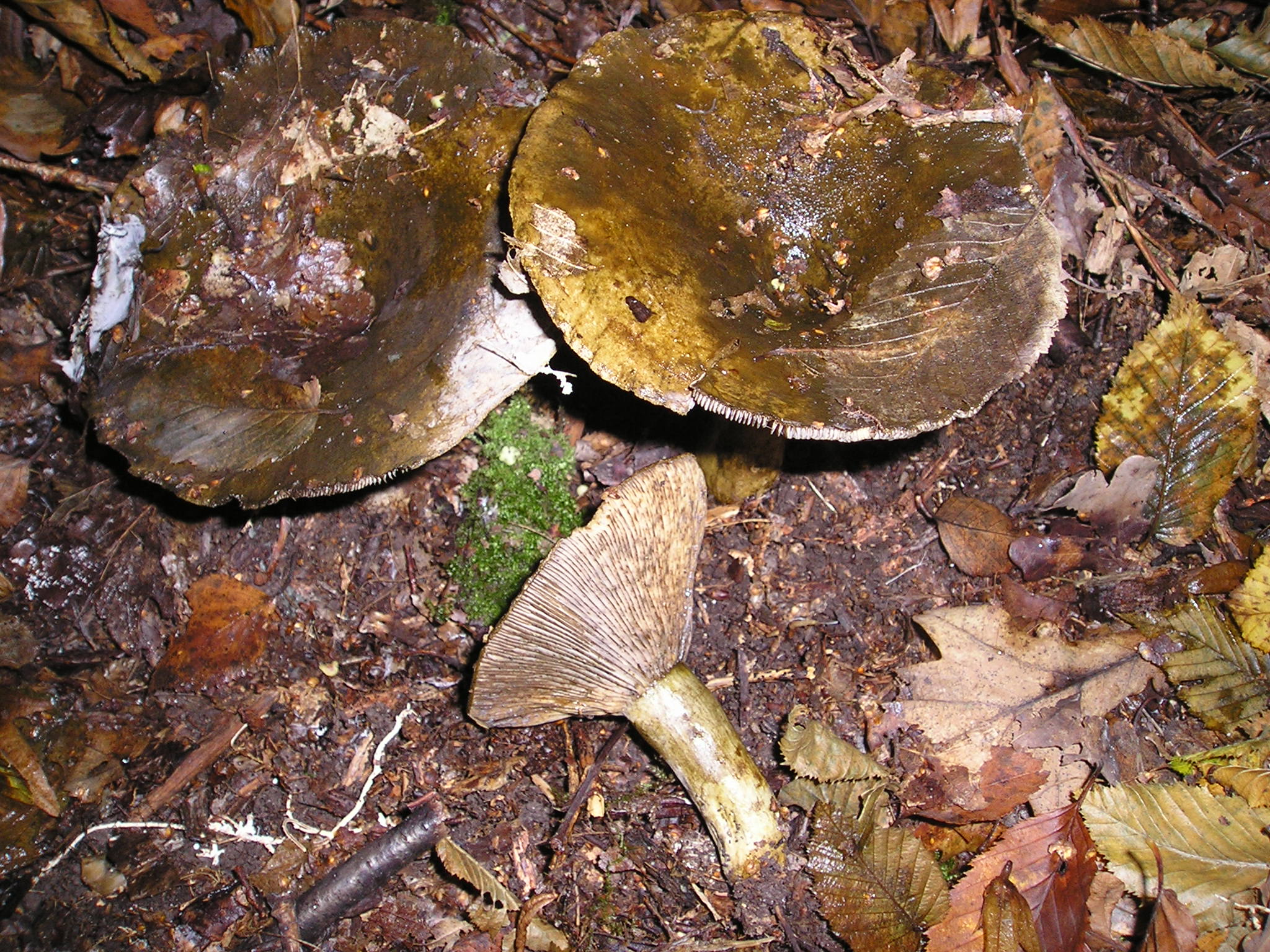- Lactarius turpis
Taxobox | name = "Lactarius turpis"

image_width = 240px
image_caption = "L. turpis"
regnum = Fungi
divisio =Basidiomycota
class =Homobasidiomycetes
ordo =Russulales
familia =Russulaceae
genus = "Lactarius "
species = "L. turpis"
binomial = "Lactarius turpis"
binomial_authority = Fr (1838)mycomorphbox
name = Lactarius turpis
whichGills = decurrent
capShape = depressed
hymeniumType=gills
stipeCharacter=bare
ecologicalType=mycorrhizal
sporePrintColor=white
howEdible=inedible"Lactarius turpis" (also "L. plumbeus" or "L. necator") [See the entry in [http://www.indexfungorum.org/Names/SynSpecies.asp?RecordID=201186 Index Fungorum] for the current name and synonyms. ] is sometimes known as the Ugly Milk-cap in English. It is found naturally in Europe and
Siberia , and has been introduced toAustralia andNew Zealand . While especially associated with birch, it is also found with spruce, pine and other trees in mixed woodland.The messy, dirty appearance, seen in the photograph, is characteristic of the species and gives it its English name and the Latin species epithet, "turpis". It seems to collect debris on top and the gills acquire a dirty brownish stain due to discoloured milk.
Taxonomy and naming
This very variable mushroom demonstrates a common phenomenon in
mycology as there is much disagreement over naming. The three main scientific designations:
*"Lactarius turpis" Fr.,
*"Lactarius necator" (Bull.:Fr.) Karsten, and
*"Lactarius plumbeus" (Bull.:Fr.) S. F. Gray,are usually, but not always [Machiel E. Noordeloos & Thomas W. Kuyper "Notulae ad Floram agaricinam neerlandicam XXXV – On the typification of Lactarius necator", Persoonia Volume 17 - 2 1999 ( [http://www.nationaalherbarium.nl/pubs/persooniaweb/pers17_2.htm abstract] )] , considered to be synonyms for same species. The epithets "necator" and "plumbeus" were both coined by Pierre Bulliard as "Agaricus necator" (1791) and "Agaricus plumbeus" (1793), but there is and was confusion as to which mushrooms were meant. The name "turpis", derived from thelatin term "turpis" "ugly", [cite book | last = Simpson | first = D.P. | title = Cassell's Latin Dictionary | publisher = Cassell Ltd. | date = 1979 | edition = 5 | location = London | pages = 883 | id = ISBN 0-304-52257-0] was originated byJohann Anton Weinmann and taken over byElias Magnus Fries in 1838. "Plumbeus" too referred to the milk-cap's appearance, derived from the Latin for "plumbeus" "lead-coloured".Description
Marcel Bon: "The Mushrooms and Toadstools of Britain and North-Western Europe" Hodder & Stoughton ISBN 0-340-39935-X.] R.F.R.McNabb "The Russulaceae of New Zealand. 1. Lactarius DC ex S.F. Gray". New Zealand Journal of Botany 9(1): 46-66 (1971) ( [http://nzfungi.landcareresearch.co.nz/html/data_descriptions.asp?from=attributes&ID=&NAMEPKey=5191 see here] ).] Phillips, Roger (1981) Entry in "Mushrooms and other fungi of Great Britain & Europe" published by Pan Books Ltd., Cavaye Place, London SW10 9PG ] [Meinhard Moser, translated by Simon Plant: "Keys to Agarics and Boleti" (Roger Phillips 1983) ISBN 0-9508486-0-3] Courtecuisse, R. & Duhem, B. (1994) "Guide des champignons de France et d'Europe" Delachaux et Niestlé ISBN 2-603-00953-2, also available in English. ]
The cap is normally 8-20 cm (3-8 in) in diameter. At first it has an involute margin and a somewhat depressed centre. The upper surface is olive brown or yellow-green and is often sticky or slimy in the middle. When young it has velvety zones and may be shaggy at the rim. Later it becomes funnel-shaped and the colour darkens to blackish. The gills are dirty white, stained olive-brown by old milk, which is initially white on contact with the air. They are somewhat decurrent. With
potassium hydroxide orammonia there is a purple reaction. The stipe is up to about 7 cm (3 in) tall by 3 cm (1¼ in) in diameter and it is similar in colour to the cap, but much lighter. It may have shallow pits (scrobiculae). The flesh is a dirty white and tends to turn brown. The taste (especially the milk) is acrid. There is little smell. The spores are about 7x6 µ and are ornamented with a pattern of ridges.Edibility
This species is reported to contain the
mutagen necatorin (=7-hydroxycoumaro(5,6-c)cinnoline), and so it cannot be recommended for eating. Boiling reduces the concentration of this compound, but does not effectively eliminate it. [See T. Suortti: "Stability of necatorin, a highly mutagenic compound from "Lactarius necator" mushroom", Food and Chemical Toxicology 1984 Jul ;22 (7):579-81 6547686. ( [http://lib.bioinfo.pl/pmid:6547686 abstract] ) and A. von Wright & T. Suortti "Preliminary characterization of the mutagenic properties of 'necatorin', a strongly mutagenic compound of the mushroom Lactarius necator." Mutation Research 1983 Aug;121(2):103-6.( [http://www.ncbi.nlm.nih.gov/sites/entrez?Db=PubMed&Cmd=ShowDetailView&TermToSearch=6348529&ordinalpos=3&itool=EntrezSystem2.PEntrez.Pubmed.Pubmed_ResultsPanel.Pubmed_RVDocSum abstract] ).]Probably due to the acrid taste, most western European authorities classify this mushroom as inedible or poor. However, it has popularly been used (after boiling) as a
spice in mushroom dishes in northern and eastern Europe and Siberia (seeMushroom picking in Slavic culture ). It is commercially available preserved in salt [See [http://www.enecopro.ru/data/en/production/catalogue/mushrooms/lactarius_necator/0010 site of YeniseyEcoproduct, Krasnoyarsk] ] . Conidered a choice mushroom in Russia, one of the best for pickling (salt only, no vinegar).References
Wikimedia Foundation. 2010.
Lactarius turpis — … Википедия
Lactarius — Milchbrätling (Lactarius volemus) Systematik Abteilung: Basidienpilze (Basidiomycota) … Deutsch Wikipedia
Lactarius — For the single species genus of fish, see False trevally. Lactarius Lactarius vietus Scientific classification Kingdom … Wikipedia
Lactarĭus — Fr., Pilzgattung aus der Ordnung der Hymenomyzeten und der Familie der Agarikazeen, fleischige, mit Milchsaft versehene Hutpilze mit häutigen Lamellen. Als Speiseschwämme werden geschätzt: der Reizker (Rietschling, Hirschling, Wacholderschwamm, L … Meyers Großes Konversations-Lexikon
Lactarius — Lactaire Pour le genre de poisson, voir Lactarius (poisson) … Wikipédia en Français
Olivbrauner Milchling — (Lactarius turpis) Systematik Klasse: Ständerpilze (Basidio … Deutsch Wikipedia
Груздь чёрный — ? Груздь чёрный … Википедия
Груздь черный — ? Груздь чёрный Научная классификация Царство: Грибы Отдел: Базидиомицеты … Википедия
Черный груздь — ? Груздь чёрный Научная классификация Царство: Грибы Отдел: Базидиомицеты … Википедия
Чёрный груздь — ? Груздь чёрный Научная классификация Царство: Грибы Отдел: Базидиомицеты … Википедия
